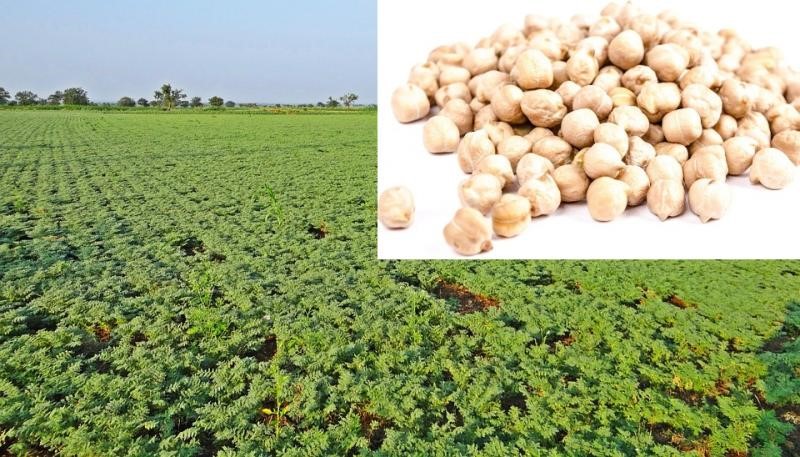Gram is a commonly renowned name of Chickpea or Bengal Gram. Farmers use it for human consumption and animal feeding also. We can use the green leaves as a vegetable while the straw of Bengal gram is a good source of fodder for cattle. Apart from this, we can also use grains as a vegetable. India, , Ethiopia, Burma, and Turkey are primarily gram growing countries. India is in the first position in respect of acreage and production, followed by MP, Rajasthan, UP, Haryana, Maharashtra, and Punjab are India’s central Chickpea producer states.
Gram has two varieties based on the seeds’ clour, shape, and size: Desi or brown gram and Kabuli or white gram. Desi gram has a high yield production compared to Kabuli gram.
How to Do Bengal Gram Farming?
We are here with complete information regarding Bengal gram farming in India. So, read the following requirements for this farming.
Climate Requirement
The temperature from 24°C to 30°C is perfect for Bengal gram farming. You should keep in your mind that the temperature must be between 24°C and 30°C. For sowing operation, the temperature must be between 24°C and 28°C. 60 to 90 cm of rainfall is suitable for Bengal gram cultivation. Apart from this, you should harvest the products at a temperature between 30°C to 32°C.
Soil Requirements
Farmers can grow it on a wide variety of soils. And for sound production, they should raise it from Sandy loam to clay loam with good drainage. They should not sow the seeds in the soil having water logging problems. Along with this, we should also skip the land, which is Saline alkaline, and the land pH level must be between 5.5 to 7. Farmers have to avoid sowing the same crop in the field. They should follow the crop rotation with cereals so that the soil-borne disease can be treated. They can rotate their crops in the following way.
- Kharif fallow-chick pea
- Kharif fallow- gram + wheat/barley/Raya
- Chari-gram
- Bajra-gram
- Rice/maize-gram
Popular Varieties with Yield
Several varieties of a gram are available in India. You can choose one of them according to your needs.
- Gram 1137 – 4.5 QTL/acre
- PBG 7 – 8 QTL/acre
- CSJ 515 – 7 QTL/acre
- BG 1053 – 8 QTL/acre
- L 550 – 6 QTL/acre
- L 551 – 6 to 8 QTL/acre
- GNG 1958 – 8 to 10 QTL/acre
- GNG 1969 – 9 QTL/acre
- GLK 28127 – 8 QTL/acre
- GPF2 – 7.6 QTL/acre
- Aadhar (RSG-963) – 6 QTL/acre
- Anubhav (RSG 888) – 9 QTL/acre
- Pusa Chamatkar – 7.5 QTL/acre
- PBG 5 – 6.8 QTL/acre
- PDG 4 – 7.8 QTL/acre
- PDG 3 – 7.2 QTL/acre
- L 552 – 7.3 QTL/acre
Other States Variety:
- C 235 – 8.4 to 10 QTL/acre
- G 24 – 10 to 12 QTL/acre
- G 130 – 8 to 12 QTL/acre
- Pant G 114 – 12 to 14 QTL/acre
- C 104 – 6 to 8 QTL/acre
- Pusa 209 – 10 to12 QTL/acre
Land Preparation
A compact and very fine seedbed is unsuitable for Bengal gram, while a rough seedbed is good. But it needs to plough to fine tilth if it grows as a mixed crop. If farmers cultivate it after the Kharif fellow, they should do one deep ploughing so the field can conserve the rainwater during the monsoon. They should do only one ploughing before sowing the seeds. With the help of excellent tractors like Swaraj 744 XT, which can give good mileage, they can run a roller if the soil seems to be deficient in moisture.
Sowing
Oct 10 to Oct 25 is a suitable time for sowing the seeds in rainfed conditions, and October 25 to November 10 is a good time for sowing in irrigated conditions. You have to complete sowing at the right time, as if you show early, then the crop is affected by wilt and causes excessive vegetative growth. On the other hand, if you sow the seeds late, it causes inadequate root development and poor vegetative growth. So just do this operation at the right time with the help of excellent tractors like Powertrac Euro 50 and others.
Apart from this, you have to keep spacing 10 cm apart, allowing 30 to 40 cm between rows. And you should sow the seeds 10 to 12.5 cm deep in the field. The popular method for sowing seeds in north India is the Pora method.
Irrigation
If farmers have irrigation facilities, they should rinse the field before sowing the seeds. It ensures smooth crop growth and proper germination. The second irrigation must be at the pre-flowering stage and one at the pod growing stage. If you face early rain, delay the irrigation and do it when necessary. Heavy and excess irrigation can enhance vegetative growth and also depresses grain yield. Along with this, it can not wear water stagnation, so proper drainage must be available.
Harvesting
The right time for harvesting is when leaves turn reddish-brown and start shedding, and plants get dry. First, you should cut the plants with a sickle. Next, you must dry the crop for 5 days in the sunshine. After the crop dries completely, do threshing by beating the plants with a stick or a thresher.
Post Harvesting
You should dry the harvested crop before storage. After storage, you have to take care of it so pulse beetle infestation can be avoided.
Now you can cultivate the Bengal gram with ease. Hope you liked it. For more information, stay tuned with us.
